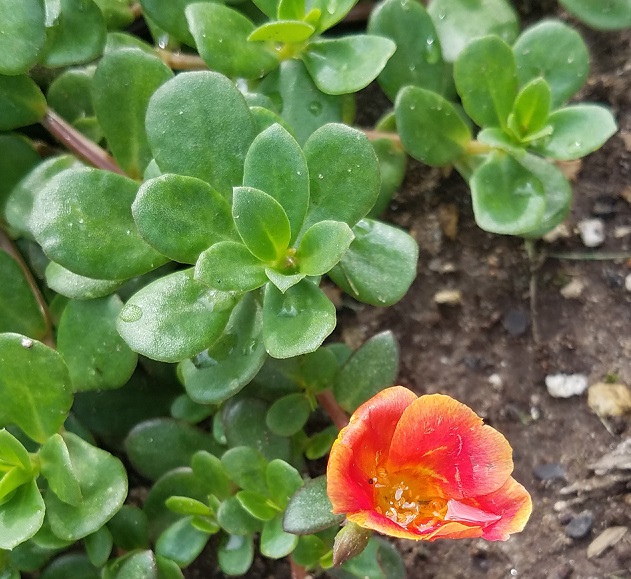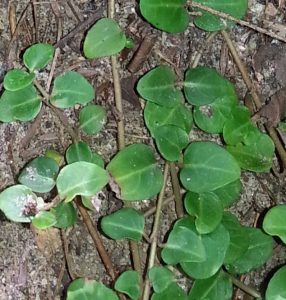Wild Purslane A Wild Edible

Purslane (Portulaca oleracea), also known as Little Hogweed, Pusley, and wild portulaca, is an edible plant that grows wild in almost every climate and region of the world. Wild Purslane is a member of the Portulacaceae family with more than 120 different species and is native to Europe and Northern Asia. It was brought into North America by colonists and is now widespread throughout the United States.
Like the dandelion, it’s an invasive species that competes with native plants, but its invasive nature and nutritional value makes it an ideal plant to forage for use as a sustainable food source.
Back to Wild Edibles
Appearance
This is a creeping plant that stays low to the ground rarely reaching over 6-inches tall. All the creeping stems will develop from one central root. Purslane is succulent and has fleshy leaves and stems. The oval leaves grow out from the stem in a set of four and will be about the size of your thumbnail when mature. The leaves are bright green, have smooth edges, and are smooth to the touch. The stems have a reddish tinge of color.
The plant will produce purple or yellow flowers from mid-spring until late autumn.
Wild Growing Locations
This wild edible thrives in a wide variety of locations where it can grow undisturbed. The most common places to find wild purslane is along riverbanks, roadsides, vacant lots, open fields, and along the edge of a wooded area.
Flavor and Uses
The flavor of purslane is often described as a cross between a green apple and celery but with a bit more tart some compare it to watercress. The leaves can be eaten raw and are crunchy, or they can be boiled or steamed like any other leafy green vegetable.
The stems from young plants can be enjoyed raw in a salad. The stems of older plants might be a little tough and will need to be prepared like broccoli stems before eating.
Flower stalks and flowers are edible and have a flavor that is slightly sour and like salty vegetables.
Wild Purslane Nutritional Value
Purslane is a powerhouse of nutrients and is a must-have food source for the food forager, homesteader, or anyone else looking to increase their sustainable food source through foraging. This wild edible is a rich source of protein and heart-healthy omega-3 fatty acids. The plant also is rich in vitamins A, B, C, and E. It’s a good source of calcium, iron, magnesium, and several other micro-nutrients and minerals. The entire plant is naturally low in calories and sodium and will increase the nutritional value of any meal or snack.
Harvesting Purslane
Because of the plant’s rapid growth habit and invasive nature, pulling up a purslane patch will not be harmful to the environment. Even though the plant is invasive, it has naturalized to its environment and will re-grow from cuttings and seeds dropped from the plant. Additionally, birds and small animals that eat the plant help disperse the seeds. I find wild purslane growing in my vegetable garden every year.
The leaves and stems will be at their most tender flavor peak when the plant is young in the early spring. Harvest young plants when planning to eat them raw.
Grow Your Own
You don’t have to rely on foraging for purslane, it’s easy to plant and grow in a container garden or at the edge of the landscape. Remember, it’s an invasive plant and will need to be confined within a container or raised bed garden so it won’t overtake other garden plants. If you have a patch of vacant landscape where the plant can grow without interfering with other food plants, that will work very well.
Select a sunny location and sow seeds directly outdoors in spring as soon as the soil can be worked and when the danger of frost has passed. Cover the seeds with one-fourth inch of soil, gently tamp down, and water thoroughly. Don’t water again unless there is a prolonged period of drought. Don’t fertilize plants.

Purslane can also be grown from cuttings quiet well. If you can cut stems close to the main stem with several sets of leaves that will be best. Cut the lower sets of leaves from the stem keeping at least two sets of leaves on the top of the stem. Stick the part of the stem stripped of leaves into a pot filled with rich moist potting mix. Keep the cuttings out of direct sun and the potting mix moist for several weeks
Poisonous Look-Alike
Spurges is a poisonous plant that looks like purslane but has one distinguishing difference – when the stem or leaves are broken it will ooze a sticky white substance. Spurges is also not a succulant so the leaves are thinner and the plant is hairy.
 creeping stems 16 inches long. It blooms from late spring to mid-summer and sets berries that typically turn red when mature. Partridgeberry is highly ornamental and is used in gardens and landscaping. It is easy to find on online
creeping stems 16 inches long. It blooms from late spring to mid-summer and sets berries that typically turn red when mature. Partridgeberry is highly ornamental and is used in gardens and landscaping. It is easy to find on online